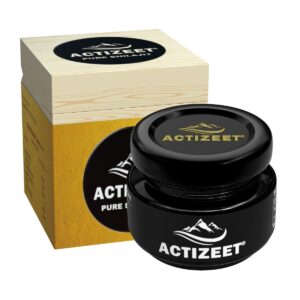Nestled deep within the heart of the Himalayan mountain range lies a mysterious substance known as Shilajit. Revered for its therapeutic properties in traditional medicine, understanding how Shilajit is made requires a journey into the geological wonders and environmental conditions that shape this unique substance. Join us as we unveil the intricacies of Shilajit formation and explore how Shilajit is made.
Table of Contents
ToggleThe Origins of Shilajit
Geological Foundations
- Mountainous Marvels:
- Shilajit is primarily found in high-altitude regions, often between 1000 and 5000 meters above sea level.
- The Himalayas, Altai, Caucasus, and other mountain ranges are prime locations for its formation.
- Ancient Rocks and Minerals:
- Shilajit forms as a result of the decomposition of plant and microbial matter trapped within rocks.
- The rocks, rich in minerals, contribute to the unique mineral composition of Shilajit.
Environmental Influence
- Harsh climatic conditions:
- The extreme temperature fluctuations in these mountainous regions play a crucial role.
- Frequent freezing and thawing cycles contribute to the breakdown of organic materials.
- Altitude and pressure:
- High altitude results in lower atmospheric pressure, impacting the decomposition process.
- The reduced oxygen levels at higher altitudes also influence microbial activity.
How is Shilajit made?
Shilajit, also known as mineral pitch, is a natural substance found mainly in the Himalayas. It has been formed over the centuries by the gradual decomposition of plant matter and minerals due to the action of microorganisms. For a long time, it has been used as Ayurvedic medicine to increase physical strength, as a dietary supplement to restore the energetic balance within the body, and for its potential to prevent certain diseases.
Recent findings have revealed that it also plays a crucial role in controlling cognitive disorders associated with ageing. The health benefits seem to differ from region to region, depending on the purity of the product and also on the place from which it was extracted.
Plant and Microbial Decomposition
- Accumulation of Organic Matter:
- Over centuries, layers of plants and microbes accumulate in rock crevices.
- The organic matter undergoes a slow decomposition process, facilitated by microbial activity.
- Humification and mineralization:
- The organic material transforms into humus, a dark, organic component of soil.
- Mineralization occurs as the organic matter combines with minerals from the rocks.
Formation of Shilajit Resin
- Fulvic Acid Magic:
- Fulvic acid, a key component, is formed during the decomposition process.
- It plays a crucial role in binding and transporting minerals, contributing to Shilajit’s unique properties.
- Exudation and Collection:
- Shilajit exudes as a resinous substance from the rocks during the warmer months.
- This exudation, often described as a sticky tar-like material, is then collected for use.
Extraction of Shilajit
Have you ever wondered how Shilajit is made? The purest form of Shilajit is the resin form. It is found naturally as a sticky, blackish-brown tar-like substance. Obtaining it in its purest form involves tremendous work. It is usually extracted from the rocky highlands, where the microorganisms naturally decompose plants over thousands of years. The extracted resin then undergoes several stages of purification so that it can be fit for consumption and provide numerous benefits to the user.
Sodhana is a term for purification in Ayurveda and is a must when it comes to Shilajit. Various herbal tinctures and other compounds are used to extract this potent resin in its purest form. The presence of impurities and dirt in the natural form of this gummy resin can tremendously lower its curative and therapeutic properties. Therefore, it is unfit for human consumption. Hence, it needs to go through several stages of purification.
How is Shilajit purified?
Shilajit is purified using various herbal concoctions, such as cow’s ghee, pure cow’s milk, Triphala decoction, and also Dashamoolarishta. However, the most standardized method of purification is using Triphala Decoction. The purification process not only removes the microbes and impurities present in the resin but also enhances the therapeutic efficacy of the product. After undergoing purification, it is packaged and sold in the form of capsules, tablets, and various other forms.
Harvesting and Purification
Traditional Extraction Methods
- Manual Harvesting:
- In traditional settings, Shilajit is often manually harvested by local communities.
- It involves careful collection to preserve the integrity of the substance.
- Sun drying and purification:
- After collection, Shilajit is sun-dried to remove excess moisture.
- Traditional purification methods may also be employed to enhance its quality.
Conclusion
In the heart of the majestic Himalayas, the formation of Shilajit unfolds as a harmonious dance between geological forces, environmental conditions, and the passage of time. This natural resin, celebrated for its health-promoting properties, encapsulates the essence of the mountains it calls home. As we unravel the intricate process of Shilajit formation, a deeper appreciation for this extraordinary substance emerges, connecting us to the ancient wisdom embedded in its creation.
Buy Pure Shilajit
-
Himalayan Shilajit, Pure shilajit, Shilajit, SHUDDH SURYA TAPI SHILAJIT
Rated 4.74 out of 5₹4,950.00Original price was: ₹4,950.00.₹3,950.00Current price is: ₹3,950.00. Incl. GST ADD TO CART Buy Now -
Himalayan Shilajit, Pure shilajit, Shilajit, SHUDDH SURYA TAPI SHILAJIT
Rated 4.78 out of 5₹9,900.00Original price was: ₹9,900.00.₹6,450.00Current price is: ₹6,450.00. Incl. GST ADD TO CART Buy Now -
Himalayan Shilajit, Pure shilajit, Shilajit, SHUDDH SURYA TAPI SHILAJIT
Rated 4.74 out of 5₹3,450.00Original price was: ₹3,450.00.₹2,450.00Current price is: ₹2,450.00. Incl. GST ADD TO CART Buy Now -
Himalayan Shilajit, Pure shilajit, Shilajit, SHUDDH SURYA TAPI SHILAJIT
Rated 4.81 out of 5₹8,400.00Original price was: ₹8,400.00.₹5,450.00Current price is: ₹5,450.00. Incl. GST ADD TO CART Buy Now







